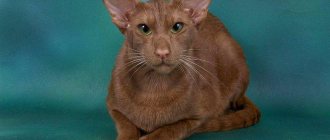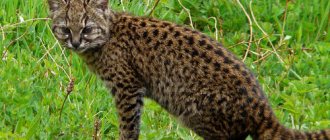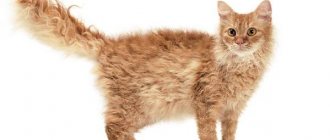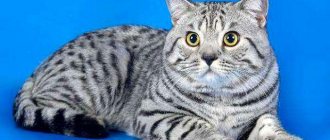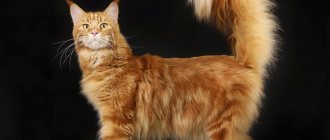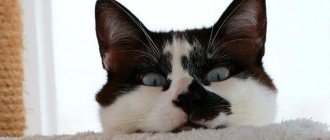The Scottish Fold is a young cat breed. The first kittens appeared a little over 50 years ago - in the 60s of the 20th century. Animals with folded ears quickly fell in love with buyers, first conquering Europe, and then moving to the United States.
One of the features due to which the black fold-eared cat has become the favorite of a large number of people is its straight stance. Imitating gophers, these animals like to sit on their hind legs, raising their body, and lowering their front legs. Only their goals are different - this is how the animals knead the bones of the spine.
Surprisingly, although the black fold cat belongs to the cat family, in most cases he is afraid of heights. This feature is due to the structure of the vestibular apparatus. But when playing, they do not jump on the curtains and rarely jump on cabinets. Fold-eared Scots love to play and fool around, but they will do it with dignity.
Solid
This coat coloring is also called plain, solid. The main feature is that the coat is uniformly colored in one color, without even the slightest inclusions of a different tone. The color is equally saturated along the entire length of the hair.
Solid suits of the “Scots”:
- blue (gray-silver);
- ebony (all black);
- red (red);
- white;
- cream;
- chocolate (rich brown color);
- cinnamon (cinnamon tones);
- lilac (beige with a lilac, pinkish tint);
- “fauns” (beige, piebald).
The most classic color for Scottish cats is blue.
Photos of Scottish cats of solid colors:
Folk beliefs about the black cat
- In England, where the lineage of fold-eared cats began, the attitude towards black animals is completely different from how they are perceived in eastern countries.
- In Scotland, meeting a black cat is considered a good omen.
- If a black cat enters someone else's house, it means that a happy surprise awaits its owners. This has been believed in the English provinces for many centuries. Therefore, a saucer of milk is often left near the house in case an unfamiliar four-legged guest arrives.
- Black cats are highly prized by British sailors. Since ancient times, such animals have been considered the best rat catchers. For the same reason, farmers selected black cats.
- For the fair sex, a black cat attracts suitors to the house and increases the girl’s chances of a successful marriage.
Bicolors
The bicolor tartan will be painted in two colors. The first one is necessarily white. The second one can be cream, tabby, black, red, blue. Breed standards require that the double coloring be symmetrical.
Photo of “Scots” bicolor:
Color points
The name of the suit is translated from English as: “color” + “point”. The body of a color point cat is white, cream, or ivory. And only the “mask” on the face, ears, tail and legs are darker in color. Depending on its tonality, there are:
- seal points (black dots);
- tabby points (striped points);
- lilac points (lavender, lilac points);
- cake points (tortoiseshell points - a combination of cream and red spots);
- blue points (blue, silver dots);
- cream points (cream points);
- Choclete points (brown, chocolate points).
The formation of the point color is interesting: a special gene causes the coat to darken only in certain areas of the body - the coldest ones. This is just the muzzle, ears, paws and tail.
Photos of color point suit owners:
Care
Most breeders talk about the low whimsical nature of cats of this breed. Their fur must be brushed daily with a massage brush. Animals get used to this quite quickly, enjoying the procedure that is beneficial for their health.
The fold-eared black cat, whose photo will decorate any catalog of breeds, contrary to stereotypes, does not resist bathing. Often gets used to water procedures after three to five times. Despite this, you can wash it only if absolutely necessary - if fleas appear or there is significant contamination.
The unique shape of the ears leads to the rapid accumulation of dust and wax in them. Therefore, you should inspect them regularly - 2-3 times a month. When cleaning, use a cotton swab coated with ear hygiene liquid.
Animals need to trim their claws no more than once a month - for this you should buy a steel nail clipper and a scratching post. The claw must be trimmed by 2 mm. You should not use scissors - this can harm the animal’s nerve endings or fingers.
Tortoiseshells
The English name for the color is torti. On the fur of the “turtles” dark spots are intricately combined with light ones. The variegated coloring must be distributed evenly over the body, which distinguishes torties from tricolor cats.
In Scottish Folds, the “tortoise” pattern occurs in variations:
- black-red;
- creamy lilac;
- chocolate red;
- creamy blue.
Interestingly, only cats can be “turtles”. In cats, this is a genetic mutation indicating infertility.
Scottish fold tortie color:
Story
The first animal of this breed, Susie, appeared in Scotland from a semi-wild cat. The father remains unknown.
Quite early, Susie began to bear offspring, which the owners had difficulty placing with friends. In 1963, a resident of Scotland, Mary Ross, received one of Susie's kittens as a gift - it was a white cat, nicknamed Snooks. Her first offspring revealed a kitten very similar to those we know today as Scottish Folds. It was a white cat with heavy paws, who was named Snowball. The owner did not have the skills of a breeder, but the woman thought that she had a chance to see the birth of a new breed.
After Snowball grew up, he was crossed with a British Shorthair. At the same time, in the next mating, Snooks was bred with a British blue. It was in this simple way that the first Scottish Fold cat was obtained at home. The black color of the first litter and folded ears attracted the interest of the breeders, who helped Mary develop the final breeding algorithm.
Over the past few decades, this breed has become one of the most sought after throughout the world. As a result of a malfunction in the gene pool that arose due to crossbreeding with short-haired cats, geneticists had to make a lot of effort to eliminate it. If both parents were lop-eared, such crossing sometimes led to disorders in the musculoskeletal system. This is what forced the use of partners of the Scottish breed who do not have folded ears in breeding.
The fold-eared black cat most often appears with normal ears. They fold only after four weeks after birth.
Smoky
Other names for the color are smokey and smoky. This is the so-called typing color: the base of the hair is light, almost white, and the tip is dark.
Among the Scots, smokey is classified as silver. The color does not allow patterns on the coat - brindle, spotted, tortoiseshell. It is easy to distinguish a smoky color from a solid color - you need to part the fur. In a smoky, it is ⅔ colored - the base of the hairs is always light.
The main variations of “smoke”:
- black;
- blue;
- chocolate.
Photos of smoky Scottish folds:
Choosing a Scottish kitten
When choosing a Scottish breed, you should neither make a mistake nor confuse it with the British or with any other breed. Before purchasing, it is useful to get acquainted with the main features and external distinctive appearance. Characteristics of Scottish kittens:
- their fur is dense, stuffed: short (Scottish Fold, Scottish Straight) or semi-long (Highland Fold, Highland Straight);
- The Scots have a large selection, about 200, of recognized colors: plain or with a variety of patterns;
- the appearance of 3-month-old kittens resembles plump bear cubs (Scottish Straight) or small owlets (Scottish Fold);
- small kittens, Scottish Fold or Straight-eared, have blue, large, widely spaced, round eyes at birth;
- the head resembles a fluffy ball with a round muzzle;
- the main feature is the shape of the ears: erect (for straights), curved forward, folded (for folds);
- mouths and noses are small and neat;
- The gender of the animal does not matter much, cats are friendly, sociable, and playful;
- Kittens must have documents: veterinary passport with the indicated vaccinations, birth certificate with entered pedigree.
It is also important to decide on one of the three classes of the Scottish kitten standard:
- Pet (PET) class, but with slight deviations from the standard. They are neutered before purchase and purchased for the soul, as a friend.
- Nonsense (BREED) class, without deviations from the standard. By agreement with the breeder, they can have offspring and participate in cat shows.
- Show (SHOW) class, the most thoroughbred with excellent pedigree. Rare specimens that meet all standard requirements. Future participants and winners of international exhibitions.
Chinchilla
Another variation of the tipped color: only a certain part of the hair is colored, and the base is white. If smoky cats have ⅔ colored hairs, then chinchillas have only ⅛ colored hairs. Because of such an unusual coloring, it seems that the white Scottish Fold has an unusual color coating. The chinchilla color comes in variations:
- golden;
- silver;
- blue golden.
The last type is the rarest, which is why its owners are the most expensive.
"Scots" chinchilla colors:
Tabby
The most common group of Scottish coat colors, which is further divided into subcategories:
- shaded - marble coloring;
- mackerel - tiger coloring;
- spotted - spotted coloring.
As for color variations, the tabby is represented by the following:
- silver (black pattern on a cold steel background);
- cameo (bright carrot stripes on a white background);
- silver-blue (gray pattern on a cold steel background);
- cream (dark beige pattern on a delicate cream background);
- red (bright red pattern on a warm peach background);
- blue (rich gray pattern on a silver-beige background);
- cinnamon (black design on a copper background).
Photos of Scottish tabby cats:
Colors of Scottish Straight cats
There is no difference in coat color variations between Scottish Straights and Folds. Cats with straight ears come in exactly the same colors as their fold-eared relatives:
- plain;
- bicolor;
- point;
- tipping;
- tabby
Similarly with the long-haired “Scots” (Highland Fold and Highland Straight), they are also characterized by all of the listed colors.
INTERESTING! As Scottish kittens grow, the color of their coat gradually changes. The final color is formed when the animal reaches 2 years of age.
The most popular are smoky, chinchilla, single-color, tortoiseshell, and shaded representatives of the straight-eared Scottish variety.
Shaded
Shedded (shaded color) is the third variation of typing colors. These cats have ⅔ white hair and ⅓ colored hair. Tipped fur does not cover the entire body, but only the back, sides, back of the head, neck, and tail. White coat - on the belly, chin, and lower part of the tail.
Shedded is represented by coloring pages:
- silver;
- golden;
- red.
Photo of “Scots” of shaded color:
Ticked
The ticked color differs from the tipped color in that the hair is colored not in two, but in three different shades:
- white on base;
- colored along the length of the hair;
- black at the tip.
Today, the ticked color is the rarest among the Scottish. Due to its lack of prevalence and amazing beauty, its bearers are much more expensive than “Scots” of other colors.
Photos of ticked Scottish folds:
Character: reviews
The Scottish Fold cat, whose character is one of its main advantages, is a creature with the kindest soul, calm, aristocratic, and moderately playful. Judging by the reviews of the owners, this pet adores its owners, gets along well with children, plays with them, practically without letting out its claws. These are very affectionate and silent creatures. Scottish Folds do not meow in vain; their voice can be quite high, or maybe slightly squeaky. The Scottish Fold cat gets along well in any family, large or consisting of one or two people, with or without other pets. The character, about which admirers of this breed have extremely enthusiastic reviews, is perfect for those people who do not like excessive fussiness and lead a measured, calm lifestyle.
Even in childhood, Scottish Folds are mischievous, as they say, in moderation. It is impossible to catch them riding on curtains or jumping from a chandelier. However, they are very fond of pens, glasses, pencils and other objects that they can carefully carry in their teeth and hide in a secluded place - under a closet or sofa. In the reviews of the owners you can read that from a young age these animals love to take the gopher pose, thereby stretching their spine. These are very clean and smart kittens with a wonderful sense of humor. If they see that the toy is in the hands of a person, they will be happy to watch his play, having a rest themselves. Adult lop-eared creatures with aristocratic imposingness allow you to admire them, but at the same time remain just as affectionate, calm, and understanding. They are always obedient if your request suits their interests. However, they can be stubborn if they don’t like something.
Unlike their relatives - the “British”, who completely ignore the presence of humans - Scottish Folds very easily make contact with people, choose their favorites in the family and spend hours next to them.
Wang
Quite an interesting coloring of Scotch cats: the cat is white, and there are colored spots on its face and tail. Several colored inclusions on the body and paws are allowed. The color of the spots can be not only monochromatic, but also tabby - marbled, striped.
Photos of Van color owners:
Harlequin
The name was given because the owner of the color is similar to a harlequin. The main color of the coat is white. And only ⅕-⅙ of the body area are colored spots. They are not concentrated in one area, but can be scattered throughout the body.
Photos of harlequin cats:
Characteristics of the Scottish breed
Scottish Folds have one obvious difference - folded ears. It is impossible to confuse these cats with anyone else. There are other distinguishing characteristics of the breed that you should know.
Standard
Scottish Folds resemble the British cat, as they are their closest relatives. But there are still differences. The description of the appearance of a representative of the Scottish Fold breed is as follows:
- Body: medium size, slightly elongated, with voluminous breasts. The limbs are round and of medium length, sometimes long.
- Head: rounded, blends smoothly into the neck. They have pronounced cheeks and a round chin.
- Eyes: round, widely spaced. Eye color depends on coat color; there are no specific standards.
- Ears: the main distinguishing feature of the breed. Small in size, widely spaced and curved forward. They have one, two or three folds. The more folds, the more they are pressed to the head and more closely follow its shape.
- Coat: Scots are typically short, plush, with a thick undercoat. There are also long-haired cats of this breed. They are called Highland Folds.
- Weight: on average from 3 to 8 kg.
- Color: any color is allowed according to the standards.
A little more about colors. The following types are distinguished:
- solid - a shade of one tone, any color: black, white, blue (cold gray), chocolate, lilac, red;
- tortoiseshell - spots of more than 2 different shades, harmoniously located throughout the body or throughout the entire coat except the chest and paws;
- smoky – plain outer coat with a silvery-white undercoat;
- chinchilla - the base of the hair color is white, and the eighth part is colored;
- tabby - color with brindle, striped, spotted or marbled patterns;
- bicolor - a combination of white with blue, black or red, preferably white on the legs, paws, stomach, chest, chin and part of the face;
- van – the main coat color is white, the tail and two spots on the head are of a different color;
- harlequin - the main part of the coat is white, and a fifth of it is of a different shade;
- colorpoint - the shade of the entire coat is light, and the paws, tail, ears and muzzle are of a contrasting color.
Reference! From birth, kittens' ears are straight; by the age of five weeks they acquire a permanent shape. It can be either curved or remain straight.
Health
The life expectancy of Scottish cats is on average 12-15 years. They are quite strong animals. They have good health until old age, with proper care and nutrition. But since the breed was created using genetic mutations, this left its mark on the health of the offspring. Folds have some hereditary diseases:
- The most common is osteochondrodysplasia . This is a genetic disease of the musculoskeletal system that causes impaired growth of cartilage and bones or their deformation.
- Entropion of the eyelid , which is removed with surgery.
- Possible development of cataracts and glaucoma .
- Ear infections.
- Partial or complete deafness.
- The risk of developing obesity due to unpretentiousness in food.
Important! It is imperative to vaccinate the animal, regardless of the conditions of detention. Cats that live exclusively in an apartment are also susceptible to infections that can be brought in by people.
Character
Scottish Folds are cats that are suitable for almost any family. Easily adapt to new surroundings. They are not intrusive, calm, soft and peaceful animals. Of all the family members, they choose one favorite, which they consider their master. In his absence, they will be bored, and when he appears at home, they will follow on his heels.
These cats do not show aggression or too much activity. Scottish Folds divide their day into approximately 2 equal parts: active with games and exploration of the apartment, and sleep. The Scots like to lie down in some interesting position, for example, lying on their backs and spreading their paws. Or stand in the meerkat pose on your hind legs.
The Scots get along well with children. They will be able to steadfastly endure the attacks of their little owners, but this does not give children the right to mock the pet. You can simply rest assured for your child if he accidentally grabs or strokes the cat more than usual. The Scots react absolutely calmly to dogs. The Scots also have special sounds. They do not purr like ordinary cats, but make something similar to a quiet squeak.
Representatives of this breed are trainable. It's easy to teach them to go to the litter box. Due to their flexibility, they can easily master simple tricks. With the right amount of patience, you can teach a Scot to use the toilet as his toilet.
Color table
To understand the numerous colors of cats, a table was created with an international classification of colors. It helps to decipher the code assigned to each representative of the breed.
The letter designations are the color of the cat.
| Symbol: | Suit: |
| a | Blue |
| b | Chocolate |
| c | Lilac |
| d | Red |
| e | Cream |
| f | "Turtle" |
| g | Blue "turtle", blue "cream" |
| h | Chocolate "turtle" |
| j | Lilac "turtle" |
| n | Black, seal point |
| o | Cinnamon |
| p | Fawn |
| q | Red "turtle" |
| r | Beige "turtle" |
| s | Silver |
| w | Unknown |
| y | Golden |
Having decided on the color, you can pay attention to other symbols. Digital designations are deciphered as follows.
| Symbol: | Meaning: |
| Type of coat color: | |
| 01 | Wang |
| 02 | Harlequin |
| 03 | Bicolor |
| 04 | Color point |
| 09 | White spots |
| Information about the structure of hair coloring: | |
| 11 | Hair is 1/4 dyed |
| 12 | Hair is dyed 1/8 |
| Distribution of color on the body and on an individual hair: | |
| 21 | Striped |
| 22 | Marble |
| 23 | brindle |
| 24 | Spotted |
| 25 | Ticked |
| Cat tail measurements: | |
| 51-54 | Tail length |
| The tonality of the animal's iris: | |
| 61 | Blue eyes |
| 62 | Yellow, orange eyes |
| 63 | Eyes of different colors |
| 64 | Green eyes |
| Characteristics of the ears of a representative of the breed: | |
| 71 | Straight ears |
| 73 | floppy ears |
